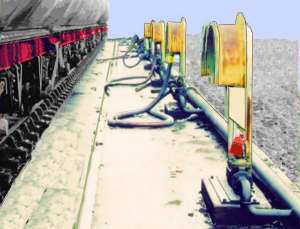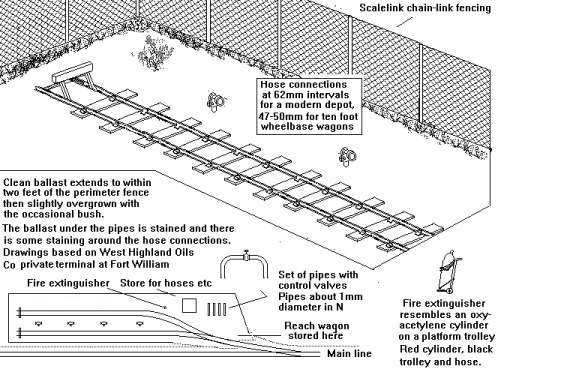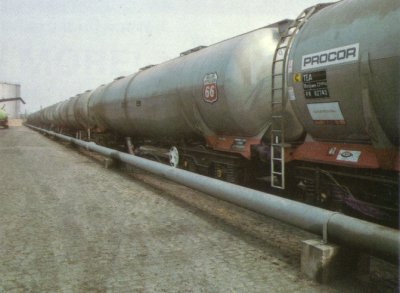Oil traffic started in the 1880's with the development of shale-oil refining in Scotland, the oils was shipped in wooden barrels. The first barrels of foreign oil arrived in the UK in 1881 and wooden barrels continued to be used to some extent certainly until the outbreak of the first world war and possibly later than that.
The often mentioned standard `Barrel' as a unit of oil measure is a 55 US gallon (35 Imperial gallon) wooden type based on the standard German beer barrel. These barrels were bought up in bulk from brewers by the first company to start operations in the USA (which became Standard Oil, known in the US now as Exxon and in Europe as Esso or Eastern Section Standard Oil). This meant that they controlled the supply of barrels and hence the movement of oil, one of the factors that lead to their eventual success.
Tanker ships carrying oil in bulk were developed in the later part of the 19th century and in the early twentieth century the growth in demand saw large tank farms and refineries set up along the river estuaries.
Bulk oil tank wagons began to appear in numbers in the early twentieth century and by 1920 there were some 10,000 Private Owner railway oil tanks on the British railway system. These tanks usually formed part of routine goods trains, generally restricted to 45 mph and many to less than that, most of the stock being rather old and worn.
Tank wagons containing flammable materials (petrol, methanol and the like) were not marshalled next to the locomotive in steam days due to the danger of fire. In photographs I have seen most single tank wagons were placed somewhere about the centre or toward the rear of the rake. Oil trains of Class A or B all had barrier wagons attached, on a BR era steam train three or four empty mineral wagons (often the fitted type) would be typical at the engine end, at the brake van end one or two minerals might be used. I have seen several photos showing BR era mixed pick-up goods trains where the oil tanks were positioned toward the rear of the train, separated from the beake van by perhaps a single (loaded or unloaded) mineral wagon. The requirement for barrier wagons on oil trains was withdrawn in (I believe) 1962 but I have not (yet) seen a photo showing a steam engine hauled oil train without the barrier wagons.
Incidentally Petrol is not the correct term for refined oil, Motor Spirit or Gasoline (as used by the Americans) are more accurate. Petrol was originally a brand name in the UK, which like `Hoover' became a part of the language.
Oil is almost always handled at purpose built establishments. Following some unfortunate accidents bottom discharge for Class A (highly flammable liquid) tanks was banned, so the loading and discharging of petrol required a raised walkway with swinging discharge pipes and hoses that could be dropped down into the tanks.
Fig___ Typical oil terminal for Class A liquids

At some point (I believe in the later 1960s) the rules changed and bottom discharge of petrol was again allowed, older wagons would still require the top discharge facilities but with modern wagons (such as the Peco long wheelbase tanks) this greatly simplifies the modelling of an oil terminal. A modern oil depot can be a very compact affair, these days the top discharge for Class A liquids is no longer required, flexible hoses leading to simple hydrant type connections are used. Generally at larger terminals there are two tracks, one to each side of the hydrants, however smaller terminals can have only a single track.
The hydrants feed into pipes which are sometimes buried under the ground, in which case the pipework usually comes to the surface close by and thereafter most pipes are above ground, supported on simple steel bench work and usually a light grey colour. At many installations there is a single large (6-10 inch (15-25cm) diameter) pipe running alongside the siding. The flexible hoses are dark grey (silver for LPG) and about four inches (10cm) diameter with a light grey coupling on the ends, the hoses are normally left attached to the valves and at modern installations there is sometimes a hooped support to carry the hose when not in use. The example illustrated below is typical, the hydrant at the front has a problem, hence no hose and a red warning label attached to it. The track is laid on bare concrete and sits in a shallow trench to contain any spillage, the hydrant and pipe are on a raised concrete platform and the area to the right is gravel.
Fig ___ Post war fuel oil terminal

Coloured bands are sometimes seen on pipes, to help the terminal workers to trace out the line. Loading valves are often painted black, red or green but the oil products break up most paints so near the hydrant connections the paint gets patchy with black areas showing through. In the sketch below the sidings are assumed to feed a set of storage tanks which are off-stage, they might be painted on the backscene or simply assumed to be out of sight. It should not be surrounded by other buildings. To keep things simple the pipes are underground, if you wish you can model the pipes using lengths of wire of various thickness', flanges can be represented with scraps of wire glued round the 'pipe'. Wrapping one in tissue paper produces a 'lagged' pipe, used for oils which need to be heated. A single thin pipe (florists steel rose wire is about right in N) should be painted bright red, this is the water spray pipe for fire fighting. The pipes are commonly supported about eighteen inches above the ground, so the terminal staff can see underneath and spot any leaks on the ground. You could use bent wire for metal pipe supports or small scraps of card painted as brick pillars.
Fig___ Typical oil terminal for Class B liquids

In 1962 the entire oil shipping side of British Railways was overhauled and after that date most oil and petroleum spirits were moved as block loads. The 100 ton tankers available from Graham Farish and the Peco 47 tonners are both typical of modern oil tankers. A typical 'trip' working of the 100 tonnners would be six or seven tanks, a single Class 47 would normally be limited to about ten wagons but longer hauls passing through could be up to twenty tankers long.
It is worth noting that a lot of oil installations had been in place for many years, some purpose built, others added to existing docks and the like. The photo below, taken from a BR publicity leafelt published in 1980, shows a 'modern' oil terminal, served by the bogied 100 ton tankers using bottom discharge for Class A liquids, but note that the roadway is cobbles.
Fig___ Typical oil terminal for Class A liquids

In the 1990's there was a move to ever longer oil trains, increasing from a typical seven one hundred ton tankers each carrying perhaps seventy tons of oil to trains carrying upwards of two thousand tons at a time. Where the receiving depot cannot handle that many tanks at one go they are parked in a nearby yard and 'tripped' to the depot in shorter rakes.
The bogie tanker that is so much a feature of modern oil operations is not in fact new, the first recorded example was built in 1900. They were not common however as they were difficult to manoeuvre in confined refineries.
My model of one of these older bogie tanks is shown in the Goods Rolling Stock Design - Rail Tanks section. My model is supposedly carrying fuel oil and the livery on the model is fictitious, the company and town names were from an old Woodhead Models coal wagon livery transfer but the remaining lettering is as per the original. Modelling this wagon is discussed in the section on 'Kit Bashing'.
Although much is made of the shift to block trains for oil it is worth remembering that there were, and are, a number of outlying depots and dealers, mainly handling heating oil. Oil fired central heating was popular for both domestic and industrial premises up to the mid 1970's when a series of oil price rises and government policy on the use of North Sea Gas made oil more expensive than gas. I would assume there are still some of these depots in operation and they would receive the odd tanker or two of oil. A smaller oil depot could be conveniently located in the local railway goods yard, cattle traffic had declined over the years and the site of the former cattle pens might be redeveloped (or even partly redeveloped) for this trade. The tanks would be quite large, in N a 'till roll' with plastic card ends would serve for a horizontal tank, but two tanks would probably be the minimum required. Add an access hatch from a disc of 40 thou card at one end and a bit of wire bent over at the top as a 'breather pipe' at the other. Alternatively the tank body from an American oil tank wagon can be used. It would be normal to enclose the tank in a brick wall so that if it leaked the spill would be contained. In addition there will be a small building housing the pump (used to transfer the oil from the rail tanks to the storage tanks and also to load delivery lorries). To load the lorries there might be a hinged filling arm rather similar to the water columns used to supply water to steam locomotives. The connection for the wagons could be a pipe with a coupling and valve set into the ground beside the track, the hoses could be represented by one inch lengths of coiled wire guitar string. A small office would also be required but given the location of the depot additional fencing is not necessary. The tanks should be located close to the track, having flexible hoses trailing across an open area would be inadvisable. There would be no route for vehicles (other than those operated by the oil distributor) between the tanks and the line. See also Lineside Industries 'Petroleum products, Oil, Petrol, LPG and Petrochemicals' for more on small oil terminals.
Where space is an issue, or where gravity was used to feed the oil from the tank to the job, tall cylindrical tanks were used. These were common in bus depots and the like for holding diesel oil and again they would have a wall around them and a small pump house close by. Bus depots are not usually rail connected but another location where this type of tank might be used would be on a quayside for supplying fuel to smaller craft such as fishing boats. This kind of tank is also used in factories where oils are blended, examples would include lubricating oil blenders.
Bitumen is the residue left after the more valuable fractions have been removed from petroleum oil. It is a thick heavy oil, often solid at normal temperatures and is usually shipped by the single wagon load. To get the fuel to flow it was necessary to heat the bitumen, either using steam or 'flame lances', the steam was fed in via a pipe and a coupling on the tank. The flame lances were inserted into tubes in the lower end of the tank, the fumes exiting through a chimney on the top of the tank at the far end. In the air braked British Railways era was usually moved in Speedlink trains, these tanks were often used as on-site storage at the receiving point. The standard bitumen tank is similar to the Peco long wheelbase tank with end ladders, but the tank ends are conical in shape. There are two stubby 'pipes' showing at the bottom (the flame tubes where the heating apparatus is connected to melt the bitumen), at the other end of the wagon, on the top, is the small chimney. Taylor Plastic Models offer a kit of parts to convert the Peco tanker into a Bitumen type.